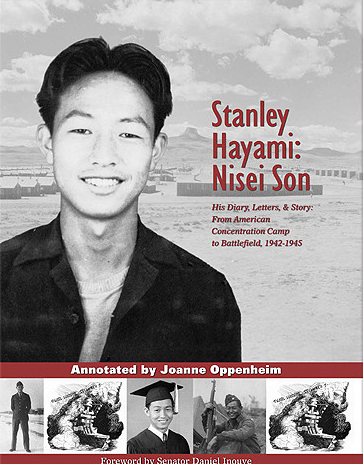Stanley Hayami, Nisei Son (book)
Creators: Stanley Hayami, Joanne Oppenheim
Book built around the wartime diary and letters of Stanley Hayami that document his incarceration at the Heart Mountain , Wyoming, concentration camp and his military service in the 442nd Regimental Combat Team .
As a sixteen-year-old, Stanley Hayami found himself at Heart Mountain in the winter of 1942 with his Issei parents, older brother Frank, older sister Grace Sachiko, and younger brother Walt. The Hayamis had run a nursery in Southern California prior to the war. On November 29, 1942, he begins a diary documenting his life at Heart Mountain. An aspiring artist, Hayami's diary also includes many drawings. To the outline provided by Hayami's diary, author Joanne Oppenheim adds written recollections from Frank (who passed away shortly before she began the project) and comments from an interview with Walt along with some of Stanley's friends. She also adds additional background information on many topics ranging from the " loyalty questionnaire " to the draft resistance movement. (Stanley's cousin's husband, Paul Nakadate , was one of the leaders of that movement.) Many of Stan's drawings, news clippings, photographs, and reproductions of some diary pages are also included. The diary ends in August 1944, when Stanley is called to active duty and leaves Heart Mountain. Oppenheim uses his letters "home" to his incarcerated family to continue the story of his basic training at Camp Blanding Florida, a brief visit to Heart Mountain over the holidays, and his eventual journey to France and Italy with the 442nd. Oppenheim uses secondary sources as well as interviews with men who served with him to tell the story of his final days, culminating with his death near San Terenzo, Italy, on April 23, 1945. She briefly covers the family's reaction to his death and the postwar lives of the rest of the family. Stanley Hayami, Nisei Son also includes a brief Foreword by Senator Daniel K. Inouye , who had been Hayami's platoon leader in the 442nd's Second Battalion, Company E. Acknowledgments, Notes, Credits and a Bibliography complete the book.
Author Joanne Oppenheim (1934– ) has authored over fifty books for children in a career that stretches back to the 1960s. Oppenheimer is also a consumer advocate and president of Oppenheimer Toy Portfolio, which reviews and recommends toys and media for children. In the process of researching her 2006 book Dear Miss Breed: True Stories of the Japanese American Incarceration During World War II and a Librarian Who Made a Difference , she came across the Hayami diary on the website of the Japanese American National Museum and immediately recognized its potential for publication. She subsequently secured the cooperation of the family, interviewing Walter Hayami, and gaining access to letters and other documents. She also received a grant from the California Civil Liberties Public Education Program for the book project.
While the book is historically accurate for the most part, there are some minor errors. In describing the roundup of enemy aliens after the attack on Pearl Harbor, Oppenheimer writes that "[n]ot one of the people arrested was ever charged, tried or found guilty of any crime" (page 9); in fact all the arrestees had hearings, though in most cases, these were little more than kangaroo courts. (Note that those forcibly removed and incarcerated as a result of Executive Order 9066 did not receive hearings or trials.) Also on page 9, she refers to the Western Defense Command as the "West Coast Defense Command". "By late spring 1942, Western portions of California, Washington, Oregon and Arizona were declared as military zones..." (9-10); the restricted area included the southern part of Arizona, along the Mexico border; later, all of California was declared off limits to Japanese Americans. She writes that Manzanar was "outside the declared 'military' zone" (27); Manzanar was in fact within the expanded restricted area. She writes that the 100th Infantry Battalion was composed of "Japanese-Hawaiian soldiers who had been part of the Hawaiian National Guard or the ROTC program at the University of Hawaii..." (56); it was the former—Nisei members of the Hawaii National Guard—who became the original members of the 100th. Those in the ROTC program were mobilized as the Hawaii Territorial Guard (HTG) after the attack on Pearl Harbor. After serving for six weeks, Nisei members of the HTG were summarily dismissed; in response, they formed the Varsity Victory Volunteers , many of whom later joined the 442nd Regimental Combat Team.
Find in the Digital Library of Japanese American Incarceration
This item has been made freely available in the Digital Library of Japanese American Incarceration , a collaborative project with Internet Archive .
Might also like
Letters from the 442nd: The World War II Correspondence of a Japanese American Medic
by Minoru Masuda;
"Wase Time!": A Teen's Memoir of Gila River Interment Camp
by Kenneth A. Tashiro; Manzanar to Mount Whitney: The Life and Times of a Lost Hiker by Hank Umemoto
| Author | Stanley Hayami, Joanne Oppenheim (annotated by), Daniel Inouye (foreword by) |
|---|---|
| Pages | 200 |
| Publication Date | 2008 |
For More Information
Author website: http://thehayamidiary.com/ .
Stanley Hayami diary online at the Japanese American National Museum: http://www.oac.cdlib.org/findaid/ark:/13030/tf687004zq/ .
